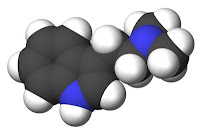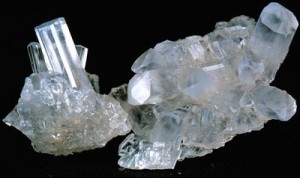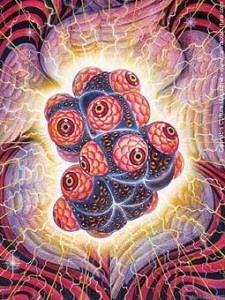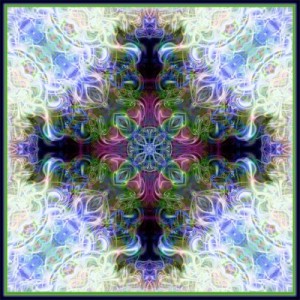Many researchers have studied the biochemical interactions through which ayahuasca produces its psychoactive effect. The current wisdom is pretty clear. The companion plant — chacruna, sameruca, chagraponga — contains the potent hallucinogen dimethyltryptamine, and the ayahuasca vine contains ß-carboline derivatives that inhibit the monoamine oxidase-A enzyme that inactivates of the dimethyltryptamine of the companion plant.
Thus the ayahuasca drink is reduced to dimethyltryptamine, its single active molecule.
 |
| The DMT molecule |
Indeed, modern science has defined medicines as having only one compound that is bioactive. This approach has solved some practical problems, such as the need to patent and standardize medicines. The idea has been that the medicinal or psychoactive effects of a plant are accounted for by specific chemicals, and that the best medicine consists of standardized, predictable dosages. Science journalist Joel Swerdlow puts it this way: “The study of whole plants and combinations is rare — largely because single active compounds, particularly those that have been modified, are easiest to patent and because FDA regulations encourage this approach.”
But there are several problems with the assumption that the ayahuasca experience is due to its single active molecule.
 |
| Ultrapure crystalline DMT |
First, there is a significant experiential difference between drinking ayahuasca and parenteral ingestion of dimethyltryptamine. Differences in the rapidity of onset and duration of the experience mean differences in the amount of time available for contemplation and exploration; the presence or absence of purging means differences in the experience of corporeality and catharsis; and, as we have discussed, the harmala alkaloids — and even MAO inhibition itself — may make independent contributions to the quality or contents of the experience.
Second, emphasis on a single active molecule has prejudiced consideration of whole plants, which can contain dozens of bioactive substances. There is little doubt that every plant contains a unique mix of multiply interacting substances in complex additive, synergistic, and antagonistic relationships, presumably in a variety of feedback loops. The fact that it is difficult to describe these relationships is no reason to decide that they are unimportant.
Yet, once it has been determined that the companion plant contains DMT, the inquiry stops. But mestizo shamans select particular companion plants — and combinations of companion plants — for their specific effects. If their only function is to provide the single active molecule dimethyltryptamine, what is there to choose among them?
 |
| Alex Grey, DMT—The Spirit Molecule (2000) |
Similarly, if the purpose of the ayahuasca vine is to contribute a single active molecule, or even just a few active molecules, whose function is to inhibit peripheral MAO, then it should not matter if another plant is substituted, as long as it contains the same molecules. But substituting, say, Syrian rue for the ayahuasca vine, even though the rue contains the same harmala alkaloids, does apparently make an experiential difference. The experience with rue has been described as crystalline, cold, overwhelming, erratic, and uncaring, compared with that of the ayahuasca vine, which has been described as warm, organic, friendly, and purposeful.
This difference may be because the harmala alkaloids are in different proportions in the two plants: levels of THH are higher in the ayahuasca vine, harmaline in rue. Experiential differences might also be due to the fact that rue contains tannins and quinazoline alkaloids not found in the ayahuasca vine. Thus, too, self-experimenters tend to use only the minimum amount of rue necessary to inhibit MAO; using more apparently serves no purpose other than to increase the emetic effect. But the amount of ayahuasca vine can be increased beyond the minimum necessary, and increasing the amount is claimed to add a special dimension to the experience.
 |
| Randy Mack, The Magic Molecule DMT (2006) |
Third, the emphasis on the single active molecule ignores the presumably complex interactions among plants deliberately used for modulatory effects during the ceremony. For example, no metsizo shamanic ceremony takes place without the additional ingestion of tobacco and all of its constituent molecules as well. The ayahuasca experience is the confluence not only of all the molecules in the ayahuasca vine and its companion plants, but also of the modulating effect of nicotine and other tobacco alkaloids — not to mention any of the scores of additional plants that may be added to the ayahuasca drink.
Finally, the focus on single active molecules ignores context. The terms pharmacologicalism and pharmacological determinism have been coined to capture the often unstated premise that the effects of a substance are entirely determined by its chemical structure, thus ignoring the effects, among other things, of traditional ceremonial settings, the authoritative presence of a healer, social pressures both within and outside the ceremony, and expectations of particular outcomes. Expectations of what is supposed to happen during an ayahuasca ceremony may be the most powerful additive of all.

- Previous Post: Ancient Andean Hallucinogens
- Next Post: Heirloom Snuffing Kits
- More Articles Related to: Plant Medicine, Research Studies, Sacred Plants



Steve,
It is good to see posts from you again after your absence of posting. I have enjoyed reading all of them.
Thanks for all the good info and the insight you provide.
Happy trails,
Ellie
Thank you for your most kind comment. I am really happy that you are getting something useful from the blog.
Greetings:
Ayahuasca and DMT give different experiences if you are fortunate to have had both you get to decide which is better for you.
I suggest only a few experiences with either to maintain your humanness.
Blessings and Beauty
Patricio